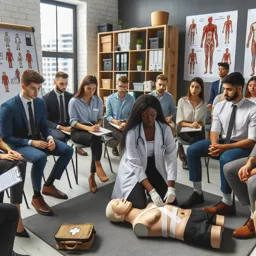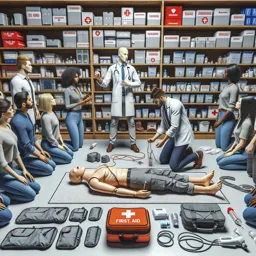Advanced first aid techniques go beyond the basics to address more complex medical emergencies. These techniques are essential for providing effective care in situations that require immediate and specialized intervention. Here’s an overview of some advanced first aid techniques for specific situations.
1. Dealing with Severe Bleeding
Techniques:
- Direct Pressure: Apply firm pressure to the wound using a clean cloth or bandage to control bleeding.
- Tourniquet Application: If direct pressure does not stop the bleeding, apply a tourniquet above the wound. Tighten until the bleeding stops and note the time of application.
- Wound Packing: If a tourniquet is not available, pack the wound with gauze or a clean cloth and continue to apply pressure.
2. Managing Fractures and Dislocations
Techniques:
- Immobilization: Use splints to immobilize the fractured limb. Avoid moving the injured area to prevent further damage.
- RICE Method: Rest, Ice, Compression, and Elevation. Apply ice to reduce swelling, use a bandage for compression, and elevate the injured limb.
- Check for Circulation: Ensure that blood flow is not restricted. Check for warmth, color, and pulse beyond the injury site.
3. Handling Spinal Injuries
Techniques:
- Stabilize the Head and Neck: Keep the person’s head and neck in a straight line with their spine. Use your hands or place padding around the head to prevent movement.
- Log Roll: If the person needs to be moved, use the log roll technique. Roll the person onto their side while keeping the head, neck, and spine aligned.
4. Treating Burns
Techniques:
- Cool the Burn: Immediately cool the burn with running water for at least 10 minutes. Do not use ice or very cold water.
- Cover the Burn: Use a clean, non-stick bandage or cloth to cover the burn. Avoid using cotton or materials that may stick to the burn.
- Pain Management: Administer over-the-counter pain relievers if the person is conscious and not allergic.
5. Managing Choking
Techniques:
- Heimlich Maneuver: Stand behind the person, wrap your arms around their waist, and perform abdominal thrusts. For infants, use back blows and chest thrusts.
- Check the Airway: If the person becomes unconscious, lay them down and check the airway. Perform CPR if necessary.
6. Providing CPR (Cardiopulmonary Resuscitation)
Techniques:
- Chest Compressions: Place your hands in the center of the chest and perform compressions at a rate of 100-120 per minute. Push hard and fast.
- Rescue Breaths: After 30 compressions, give two rescue breaths. Tilt the head back, lift the chin, and breathe into the person’s mouth.
- Continue Until Help Arrives: Continue CPR until medical help arrives or the person shows signs of life.
7. Handling Poisoning
Techniques:
- Identify the Poison: Determine what substance the person has ingested. This information is crucial for medical professionals.
- Do Not Induce Vomiting: Unless instructed by a poison control center, do not induce vomiting.
- Call Emergency Services: Contact emergency services or a poison control center immediately for guidance.
8. Managing Seizures
Techniques:
- Protect from Injury: Move objects away from the person to prevent injury during the seizure.
- Do Not Restrain: Do not hold the person down or put anything in their mouth.
- Recovery Position: Once the seizure ends, place the person in the recovery position (on their side) to maintain an open airway.
Conclusion
Advanced first aid techniques are crucial for managing severe and specific medical emergencies. By learning how to deal with severe bleeding, fractures, spinal injuries, burns, choking, CPR, poisoning, and seizures, you can provide effective and potentially life-saving care. Always remember to seek professional medical help as soon as possible in any emergency situation.




























